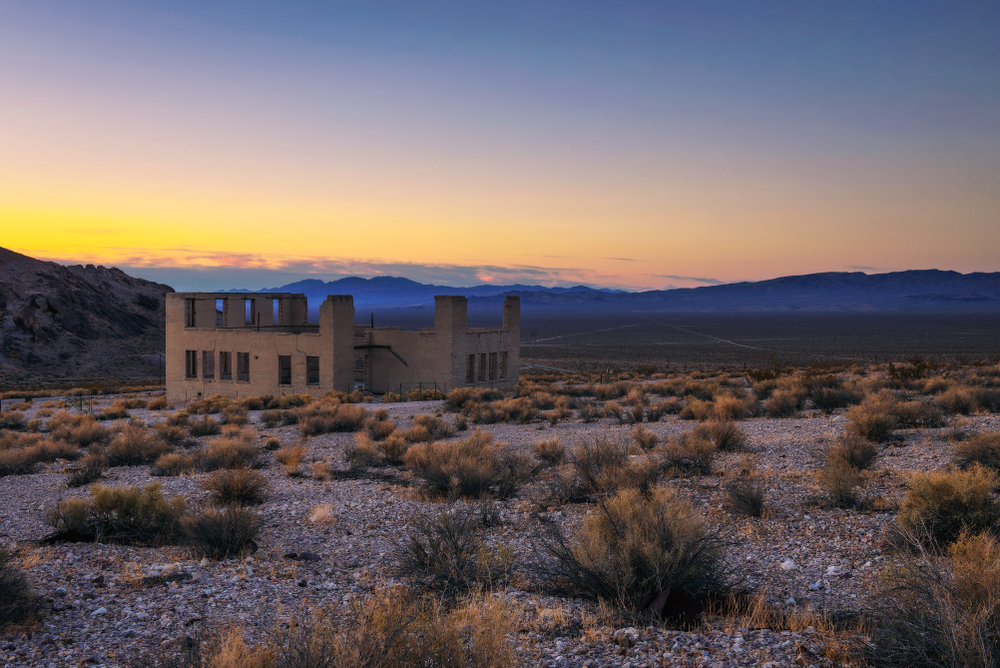Nestled in the desolate Bullfrog Hills 120 miles from Las Vegas, stands the ghost town of Rhyolite. Near the edge of Death Valley, this once-thriving boomtown sprang up in 1905 when gold was discovered nearby; the death of Rhyolite proved to be equally dramatic.
By 1907, Rhyolite had electricity, running water, concrete sidewalks, telephones, and a telegraph line. There was a hospital, a school, newspapers, a monthly magazine, police and fire departments, a train station, an opera house, three banks, a stock exchange, a public swimming pool, and two churches. The three-story John S. Cook and Co. Bank was completed in 1908, at a cost equivalent to more than $2.5 million in today’s money.
By 1911, all the mines were closed, and by 1920, the remnants of the once-bustling Rhyolite had been turned into a tourist attraction. The town’s population had peaked in 1908 at between 3,500 and 5,000 people, and just a few years later, the town was completely abandoned. Many of the buildings were subsequently cannibalized for building materials and some were moved to other towns. For example, the Miners’ Union Hall was moved to Beatty to be used as the Old Town Hall, and many of the two-room miners’ cabins were moved there too.
Today, the ghost town of Rhyolite is operated by the Bureau of Land Management. Since its decline and ultimate death, Rhyolite has become not only the most photographed ghost town in the West, but also a movie set. First to be filmed here was the 1925 silent movie, The Air Mail. Later, the remains of the Cook Bank Building were to serve as a backdrop for the 1964 movie The Reward, followed by The Island in 2004. Rhyolite was also the scene of the dystopian, 1987 science-fiction movie Cherry 2000, and 1998’s Six-String Samurai.
Visiting Rhyolite from Las Vegas
Rhyolite is a straight shot on US 95 north, past Nellis AFB to Beatty. From Beatty, take a left on Airport Road, then left on NV-374 S. The total time to get there from Las Vegas should be two hours or less.
If you need gas, you might remember to stop at the Area 51 Travel Center in Amargosa Valley; the travel center is an unusual alien-themed gas station, convenience store and legal brothel. Up front, you have a gas station and a convenience store filled with gray alien kitsch, while out back, there’s the Area 51 Alien Cathouse Brothel. If you need a dose of Nevada humor, then this is it.
Beatty, Nevada
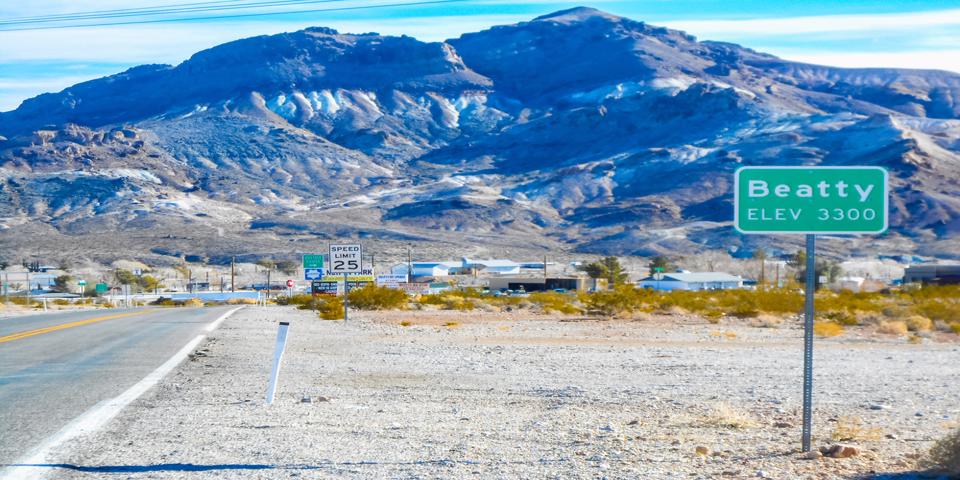
As you pass through Beatty, watch out for wild burros on the road; there is not much in Beatty other than RV parks, gas stations, and a few restaurants. Main Street is lined with a few old-West-style saloons, but the Stagecoach Casino and Hotel is the largest establishment here. If you have a sweet tooth, the Death Valley Candy and Nut Co. is one of the biggest candy stores you’ll ever see, and if you need some snacks for Rhyolite, this is a good place to stop. There is also a Subway and a Denny’s here, if you need a meal.
While you’re in Beatty, stop in at the Beatty Museum at 417 Main St. The museum is free, and is chock full of odds and ends from the Bullfrog Mining District, as well as the mining camps of Nye County. Beatty was founded around the same time as Rhyolite, but has survived into the 21st century as “the gateway to Death Valley”.
The Goldwell Open Air Museum
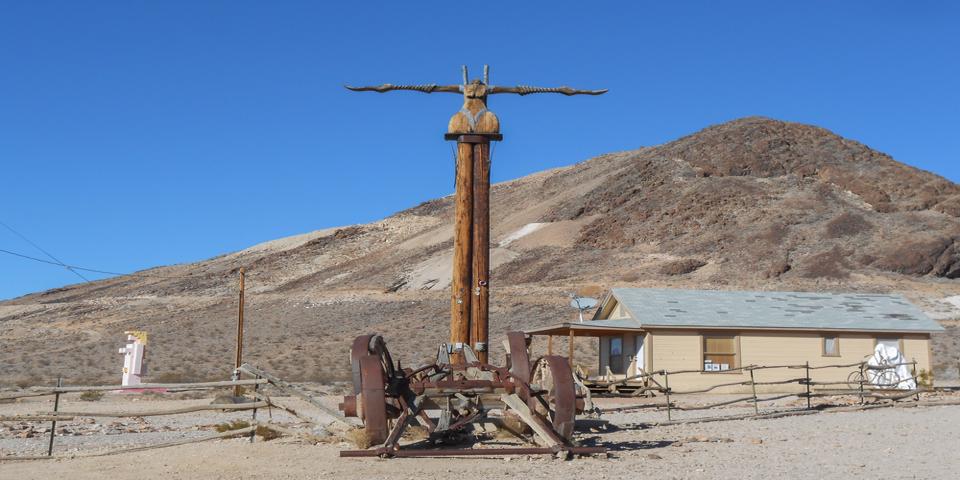
As you approach Rhyolite, you’ll encounter a strange landscape of avant-garde sculptures including a ghostly apparition of Leonardo DaVinci’s The Last Supper. This is the work of Albert Szukalski, who created the figures by draping wet, plaster-soaked burlap over real people until the plaster was dry.
Albert Szukalski was a Polish-Belgian mixed-media artist who traveled to Rhyolite in 1984 to create the Last Supper “ghosts”. Szukalski died in the year 2000, and the nonprofit Goldwell Open Air Museum was organized not only to preserve Szukalski’s work, but also to host an artist-in-residence program and to expand the outdoor exhibition space.
One thing you’ll notice right away is the Red Barn Art Center, a 2,250-square-foot art studio and exhibition space used by the artists in residence as well as other artists. The art center sits among the ruins of another historic mining town called Bullfrog which–at its height in 1904–had 1,000 people living here in tents and dugouts. All that’s left now are the ruins of the old jail at the base of Bonanza Mountain.
The permanent collection here is comprised of work by European artists. Besides the work of Albert Szukalski, there are sculptures by Dr. Hugo Heyrman, Dre Peeters and Fred Bervoets of Belgium, and by German artist Sofie Siegmann.
Visiting this European sculpture garden in the middle of the Nevada desert is a haunting experience; it seems strangely out of place, nestled on the edge of a ghost town.
Rhyolite, Nevada
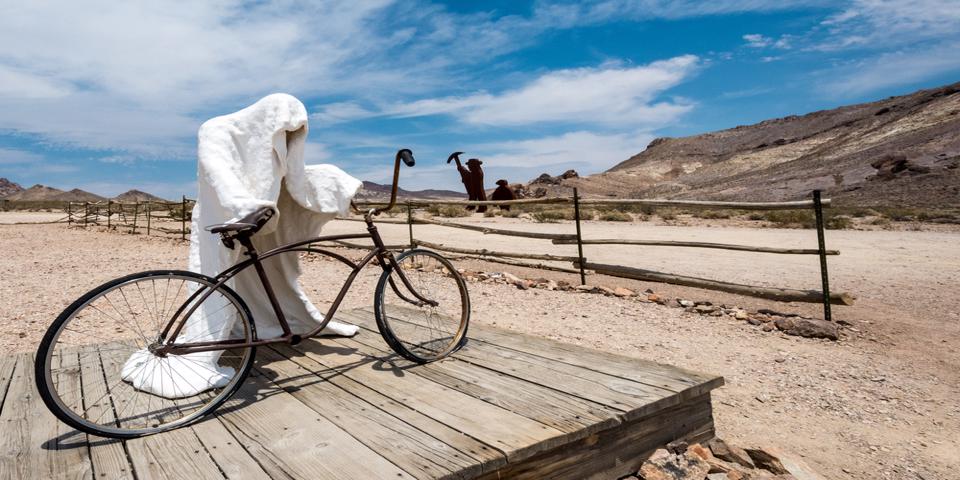
The most famous building here in Rhyolite is Tom Kelly’s Bottle House. In fact, the Bottle House currently serves as an inspiration for many people wishing to build a “green” home using recycled materials.
Tom Kelly ran one of the 50 saloons in Rhyolite, and the 76-year-old Australian wanted to build a home. Tom used bottles because “it’s very difficult to build a house with lumber from a Joshua tree.” Fortunately, used beer bottles were an abundant resource in this mining camp, and Mr. Kelly used mud to cement together 50,000 glass bottles into a three-room home. Most of the building materials were Busch beer bottles that came from Mr. Kelly’s own establishment, and more were donated from the 50 other saloons that once existed in Rhyolite. It took Mr. Kelly five-and-a-half months to finish the house.
A house built out of bottles is surprisingly strong, and the air pockets created by the bottles act as relatively good insulation. Tom Kelly’s wasn’t even the only bottle house in Rhyolite; there were three others that have since disappeared.
The Railroad Depot
The other well-maintained building in Rhyolite is the old railroad station. In 1906, the Las Vegas and Tonopah Railroad arrived in Rhyolite. Building the Spanish-revival-style railroad station in 1905 cost $130,000, around $3,715,000 in today’s money. During the 1930s, the depot was transformed into a casino and saloon, and later became a museum and souvenir shop. Today, the abandoned depot is one of the few buildings left in Rhyolite that has not crumbled.
Across from the depot is the caboose house. Building materials are scarce, so just like the bottle house, someone creatively turned an old caboose into a home. In fact, caboose homes were once common in America’s Old West, and during the 1920s, this caboose served as a gas station along with a fuel storage tank and a pump.
Porter Brothers Store
The front facade of the Porter Brothers Store still stands. Built in 1902 and closed in 1910, the store once had big glass windows in which to display its mining supplies, food, and sundries for sale. The enterprising Porter Brothers also had stores in nearby Beatty, Ballarat, and Pioneer. One of the Porter Brothers remained in Rhyolite until 1919.
The Old Schoolhouse
Rhyolite’s school once had more than 200 students. This is Rhyolite’s second school, and it cost $20,000 to build it in 1909; that’s $565,000 in today’s money. The concrete building once had a bell tower and a Spanish tile roof.
The John S. Cook and Co. Bank
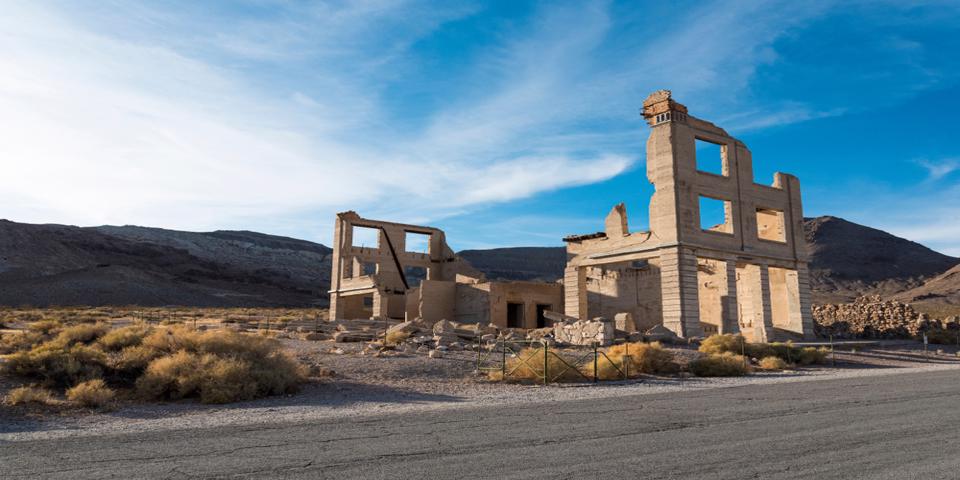
The bank was finished in 1908 at a cost of $90,000, equivalent to more than $2.5 million today. This empty shell was once graced with an Italian marble staircase and floors, mahogany woodwork and stained-glass windows imported from Europe. The building had both electricity and indoor plumbing. It closed its doors in 1910, and the precious building materials were quickly taken and used elsewhere.
The End of Rhyolite
One of the most striking facts about Rhyolite was the amount of money poured into building this town, yet how quickly it faded away. Within fewer than ten years, as many as 5,000 people came to live here and–just as quickly–left. When the mines closed, the businesses failed, and people had to seek work elsewhere. The bank, the post office, and train depot were all closed by 1914. That same year, the power company shut down the electricity. By 1920, only fourteen hardy people still called Rhyolite home.
Nevada is a state with nearly a hundred ghost towns, and Rhyolite is the premier example of the boom-and-bust economy of the Gold Rush days. While Rhyolite is the best-known Nevada ghost town, dozens of others are tucked away in the forgotten corners of the state. Berlin, Fort Churchill, Metropolis, Ione, Hamilton and dozens more are all there for the intrepid explorer to discover.
On your way back from Rhyolite, stop in at Beatty for dinner and to fill up on gas. While Rhyolite and many other towns have faded away, somehow, Beatty has survived.

